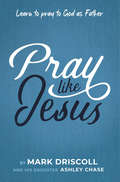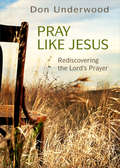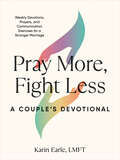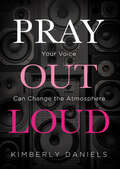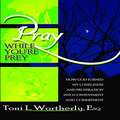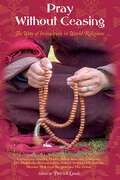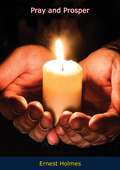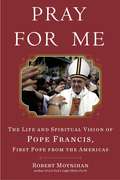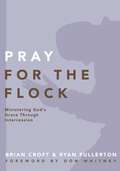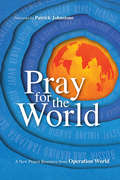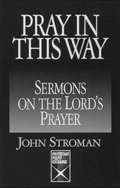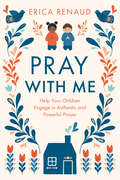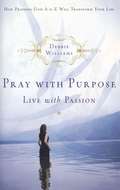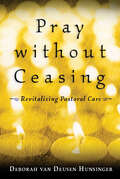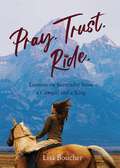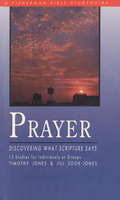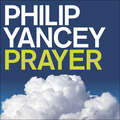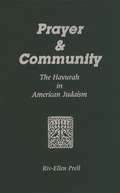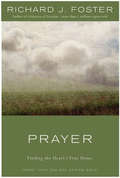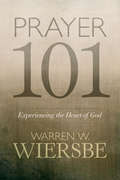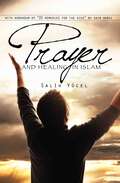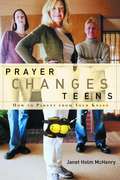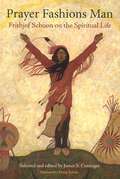- Table View
- List View
Pray LIke Jesus: Learn to Pray to God as Father
by Mark Driscoll Ashley ChasePraying like Jesus doesn&’t just change your prayer life; it changes your entire life. There are many books on prayer, and books on Jesus, but there is a need for a book about the prayer life of Jesus since His prayer life alone was the perfect prayer life. How did Jesus pray? Why did Jesus pray? Where did Jesus pray? These questions and more will be examined as we look at what Jesus taught about prayer, as well as what Jesus modeled in prayer. This book will be biblical, practical, and easy to read so that it is accessible to a broad audience. Many people, Christian and non-Christian alike, statistically value prayer and try to have some sort of prayer life. But most people struggle to build any momentum in their prayer lives when they fall into a rut. In Pray Like Jesus, Mark and Ashley want to help people build momentum in their prayer lives by experiencing the presence of God in an ever-deepening, life-giving, burden-relieving, and hope-lifting relationship with Jesus Christ.
Pray Like Jesus Leader Guide: Rediscovering the Lord's Prayer
by Don UnderwoodThe Lord’s Prayer is the most famous prayer in the world and is remarkably simple and brief. In only 70 words Jesus covers the breadth of the Christian message and experience. Most Christians already know it by heart and can easily recite it. In fact, that might be part of the problem—it is so well known and easily recited that most of us never even think about the words as we rattle them off silently or in a corporate worship setting.In Pray Like Jesus, pastor and author Don Underwood reexamines the content of the Lord’s Prayer and discovers within it insightful spiritual guidance for developing a rich devotional life. And the end of each chapter, he suggest ideas for making the prayer a part of daily spiritual disciplines.The Leader Guide contains everything needed to guide a group through the six-week study including session plans and discussion questions, as well as multiple format options.
Pray Like Jesus: Rediscovering the Lord's Prayer
by Don UnderwoodThe Lord’s Prayer is the most famous prayer in the world and is remarkably simple and brief. In only 70 words Jesus covers the breadth of the Christian message and experience. Most Christians already know it by heart and can easily recite it. In fact, that might be part of the problem—it is so well known and easily recited that most of us never even think about the words as we rattle them off silently or in a corporate worship setting.In Pray Like Jesus, pastor and author Don Underwood reexamines the content of the Lord’s Prayer and discovers within it insightful spiritual guidance for developing a rich devotional life. At the end of each chapter, he suggest ideas for making the prayer a part of daily spiritual disciplines.Endorsements"Don Underwood combines pastoral experience with biblical and theological insight to help us rediscover the Lord's Prayer and allow it to become a living reality in our lives." James A. Harnish, author of A Disciple's Path, A Disciple's Heart, and Living with the Mind of Christ."Don points out that the disciples asked Jesus to teach them to pray, not after hearing the Master give a powerful sermon, but after watching him pray. They saw what prayer did for him, and they wanted it, too!" James W. Moore, author of Yes, Lord, I Have Sinned, but I Have Several Excellent Excuses
Pray More, Fight Less: Weekly Devotions, Prayers, and Communication Exercises for a Stronger Marriage
by Karin EarleA couple&’s devotional for fighting less in marriages, featuring weekly scripture, prayers, and faith-based skills-building exercises for navigating through difficult conversations and for establishing healthy communicationEven the healthiest of relationships can be thrown off-balance when there are breaks in communication and trust. Pray More, Fight Less by Karin Earl, LMFT, helps couples find spiritual and practical support while recentering marriages on God. Faith-based therapy exercises round out the weekly devotions to guide couples who are navigating through conflict establish healthier communication and stronger bonds.Pray More, Fight Less features:• 52 WEEKS OF PRAYERS AND DEVOTIONS: Powerful scripture and God&’s truths with real-life anecdotes provide guidance on refocusing marriages on God when communication and trust break down. Each devotion offers a prayer for God&’s strength, wisdom, and healing in seasons of conflict.• FAITH-BASED COMMUNICATION EXERCISES: Practical faith-based exercises and activities to help married couples navigate through conflict, build communication skills, and establish stronger connections • LICENSED FAMILY THERAPIST: Author and therapist Karin Earle, LMFT&’s, credentials and passion help others to live and experience spiritual healing
Pray Out Loud: Your Voice Can Change the Atmosphere
by Kimberly DanielsMore than 95 percent of the psalms express or invite audible words. This book will inform, equip, and inspire you to proclaim prayers that spread the gospel. We are living in times of great discrimination against the message of the church. Special interest groups boldly stand on platforms and speak out in ways much like Goliath did when he mocked the armies of the Lord. The generals of that time hid and were afraid to speak out, but we must learn from their mistake. God is recruiting voices from the wilderness of the America we live in today to stand and speak truth in love. The general attitude of many people is that prayer should be offered up only in the privacy of sanctuaries or the seclusion of prayer closets. This book defies that idea. As others are boldly coming out of the closet for whatever they are passionate about, so should believers! We know that there is life and death in the power of the tongue. We also know God&’s people perish for a lack of knowledge. Pray Out Loud not only informs and trains readers; it also equips them with prayers and declarations so they can intercede with power. This book encourages Christians to refuse to be silenced and instead to become violent interrupters who stand in the gap and with loud voices proclaim the gospel of Jesus Christ. FEATURES AND BENEFITS:Trains and equips you to overcome intimidation and receive impartation to intercede with power Includes declarations and decrees for intercession and spiritual warfare
Pray While You're Prey: How God Turned My Loneliness and Frustration into Contentment and Commitment
by Toni WortherlyBeing single is not a prison sentence. It is not a cage that holds you captive. In fact, it is the ultimate freedom. It is freedom to discover God’s will for your life, to live a fulfilling life. It is the ability to run free in this jungle of a world, knowing that when the time is right, a good hunter will snare you and hold you captive, while God reveals a new purpose for you. If anyone had said these things to me, even while I was writing this book, I would not have believed it, but God led me on a journey. A journey from frustration to contentment. A journey from loneliness to commitment. Not the commitment with a man that I thought I longed for, but a commitment to Christ that my soul yearned for. I stopped chasing a dating dream and started serving a risen reality. God revealed things that I needed to change about me, the types of hunters that exist, the ones that are best for me, how to escape a predator called loneliness, and have a Godly relationship once I’m captured. And I know that God didn’t just lead me on the journey for me; He intended for me to share my journey with others.
Pray Without Ceasing: The Way of the Invocation in World Religions
Drawn from the world''s religions, this work takes the reader on a pilgrimage to the heart of prayer and reveals why prayer is the essence of the human condition.
Pray and Prosper
by Ernest HolmesIn this essay, which was first published in 1944, the distinguished New Thought leader, Ernest Holmes, discusses his understanding of prayer and its relationship to the infinite, the meaning and objective of prayer, and prayer’s relationship to internal spiritual transformation.
Pray for Me: Finding Faith in a Crisis
by Rick HamlinIn a crisis, all you can do is trust. You have to surrender, and surrender is at the heart of prayer.When Rick Hamlin was rushed to the ER, he was immediately admitted to the ICU. No quick diagnosis was made, and for two weeks the doctors struggled to keep his body alive as Rick struggled to keep his faith alive. PRAY FOR ME is the story of one man's spiritual odyssey to learn how to pray in a new way as healing slowly came and a medical crisis became a spiritual opportunity--a chance for him to learn he was being called to something new, to be born anew. In the end the doctors were never able to diagnose the cause of his illness, but Rick is convinced that the healing came through prayer.
Pray for Me: The Life and Spiritual Vision of Pope Francis, First Pope from the Americas
by Robert MoynihanFrom the founder and editor of Inside the Vatican magazine, the world's most well-informed, comprehensive monthly on the Roman Catholic Church, comes this enlightening introduction to the life and spiritual teachings of Jorge Mario Bergoglio, now Pope Francis, the first Pope of the Americas.On March, 13, 2013, 115 Cardinals elected for the first time a Pope from outside of Europe. Pope Francis, a native of Argentina, is not just the first Pope from the Southern Hemisphere, he is also the first Jesuit to ever hold the Chair of Peter. This means a bridging of the Northern and Southern hemispheres and religious traditions in a way we've never seen before, signifying a new global vision for the 1.2 billion people who call themselves Catholic.Now a leading expert on the papacy provides the ultimate introduction to this new Pope, including biographical information and an absorbing collection of Jorge Mario Bergoglio most persuasive words.
Pray for the Flock: Ministering God's Grace Through Intercession (Practical Shepherding Series)
by Brian Croft Ryan Fullerton“Brothers, pray for us.” (1 Thessalonians 5:25). The Apostle Paul’s letters are filled with references to prayer—requests for prayer from the churches, prayers for them, and teaching and encouragement that God was working through these prayers. Pastors and church leaders know that prayer is powerful and it must be a priority in any ministry, yet many pastors struggle to maintain an active prayer life. Even more difficult is the challenge of praying for the flock, lifting up the needs of the people God has placed in your care.The Practical Shepherding series of guides provides pastors and ministry leaders with practical help to do the work of pastoral ministry in a local church. In Pray for the Flock, pastors Brian Croft and Ryan Fullerton provide biblical encouragement, practical advice, and helpful suggestions that will help busy pastors effectively pray for their people and care for their church through the ministry of intercession.
Pray for the World: A New Prayer Resource from Operation World (Operation World Resources)
by Molly WallOperation WorldOperation WorldPray for the WorldOperation WorldPray for the WorldTimely challenges for prayer and specific on-the-ground reports of answers to prayerPopulation and people group statisticsCharts and maps of demographic trendsUpdates on church growth, with a focus on evangelicalsExplanations of major currents in economics, politics and society
Pray in This Way: Sermons on the Lord's Prayer (Protestant Pulpit Exchange Series) (Protestant Pulpit Exchange Ser.)
by John StromanPray in This Way: Line by line imaginative, literary and social-commentary sermons on the Our Father. Each chapter contains framed call-outs in lieu of subheads and as a means to providing customers with key ideas that lead to the construction of their own sermons.
Pray with Me: Help Your Children Engage in Authentic and Powerful Prayer
by Erica RenaudThis grace-filled, practical book on praying with your kids empowers you to teach children how they can develop a personal relationship with God through prayer. As parents, our deep longing is for our children to not just know about Jesus but to love Him. In Pray with Me, parent and ministry leader Erica Renaud shows us how inviting kids into the joy of intentional prayer—on their level—nurtures authentic relationship with God that can last a lifetime. Through relatable stories, biblical insight, and practical tips for involving the whole family in prayer, Erica equips us to: Overcome the challenges of praying with kids by learning how to engage their hearts.Encourage prayer in response to everyday joys and struggles.Get creative about when, how, and what to pray.Express the theology of prayer in age-appropriate language, for preschoolers to tweens.Let go of the insecurity that keeps us from praying with our kids. As our children grow spiritually, we can too—and together, love Jesus more every day.
Pray with Purpose, Live with Passion: How Praising God A to Z Will Transform Your Life
by Debbie WilliamsIn this reflective guide, Debbie Williams walks you through the discipline and relationship of prayer—a new life of passion and purpose awaits you.With an enthusiastic invitation to use her book as an interactive guide to deepen the reader's prayer, Debbie Williams sets out to redirect the focus from us to God, who is divine, and who can accomplish all things. Using the acronym PRAY for Praise, Repent, Ask, and Yield, she encourages a study of God's attributes with an A-Z exploration which ranges from Almighty to Zealous God. Each chapter reveals more of who God is and how He alone is capable to meet our every need as we recognize who He truly is.
Pray without Ceasing: Revitalizing Pastoral Care
by Deborah van HunsingerTaking seriously Paul’s exhortation in 1 Thessalonians to “pray without ceasing,” Deborah van Deusen Hunsinger challenges pastors and congregations to put prayer at the center of their Christian practice and theological reflection. In this thought-provoking book Hunsinger reclaims spiritual practices from token use and unites them in a dynamic network of interdependent caring traditions. The book begins with the three foundational disciplines of spiritual reading, careful listening, and self-reflection. Hunsinger then explores prayers of petition, intercession, confession, lament, and thanksgiving. Finally she offers practical, workable suggestions for developing pastoral care groups and teaching care-giving skills at the congregational level. Clergy and laity alike will reap the benefits of this revitalizing look at the spiritual disciplines as dynamic forces in the life of the church.
Pray. Trust. Ride: Lessons on Surrender from a Cowgirl and a King
by Lisa BoucherPray. Trust. Ride: encourages you to stay in the saddle and ride through life with a looser rein. We live more fully when we can let go— even when all looks bleak and our brains scream, Hang on and do something! Do anything! Fix this! Stop that! The truth is, those problems that strangle our hearts are the sort of problems that we can&’t fix. King Jehoshaphat understood that when he was boxed in by his enemy; at his most vulnerable moment, he leaned on God and let go of the outcome. Using this approach as her guiding principle, Lisa Boucher shares in this helpful guide how to lean on spiritual principles to help people live with less anxiety and strife, and how letting go allows us to accept that we can&’t solve all our problems; we can&’t save others from themselves; we can&’t stop the inevitable from happening. What we can do is let go and trust that God has our backs.
Prayer
by Timothy Jones Jill ZookWant More for Your Prayer Life!Few areas of the Christian life inspire more resolutions--or create more guilt--than prayer. Most of us share the longing expressed by Jesus' disciples, "Lord, teach us to pray." Like them, we see a depth and reality in Jesus' relationship with the Father that makes us restless for something more. The wonderful news is that Scripture is filled with guidance for talking with God. As we study and apply its teaching, our own prayer life will become intimate and fruitful, daily growing more like the prayers of Jesus. 12 Sessions for Individuals or GroupsFisherman Bible Studyguides include: . Penetrating questions that generate discussion. . Flexible format for groups or individual needs. . Helpful leader's notes.. Emphasis on daily application of Bible truth.
Prayer
by Philip YanceyMulti-award winning spirituality writer Philip Yancey is loved throughout the world for his honest, insightful and inspirational writing. PRAYER: DOES IT MAKE ANY DIFFERENCE? carries all the hallmarks of classic Yancey, a journalist by training. His quest to unravel the mysteries of prayer reads as the journal of a fellow traveller: questioning, challenging, lamenting the unexplainable and rejoicing in the discovery of awesome insights. His journey is beautifully illustrated with moving true stories drawn from around the world.PRAYER: DOES IT MAKE ANY DIFFERENCE? tackles the following questions: What is prayer? What difference does it make? Why and how should we pray? What about unanswered prayer? How should we understand prayer for physical healing?Focusing on such a universal theme, this is potentially Yancey's biggest book yet. To date, his books have sold over 14 million copies, and have been translated into 25 languages. His first book with Hodder, SOUL SURVIVOR, sold over 90,000 copies in just five years.(P) 2006 Zondervan
Prayer & Community: The Havurah in American Judaism
by Riv-Ellen PrellRiv-Ellen Prell spent eighteen months of participant observation field research studying a countercultural havurah to determine why these groups emerged in the United States during the 1970s. In her book, she explores the central questions posed by the early havurot and their founders. She also examines the havurah as a development of American Judaism, continuing-rather than rejecting-many of the previous generations' ideas about religion. Combining history and ethnography, Prell uses current theories about ritual and prayer to understand men's and women's struggles with their religious tradition and their desire to create community.
Prayer - 10th Anniversary Edition: Finding the Heart's True Home
by Richard J. FosterWinner of numerous honors, including Christianity Today's Book of the Year and the Evangelical Christian Publishers' Association Gold Medallion Award, this life-changing book shows how each of the various forms of prayer can move us inward into personal transformation, upward toward intimacy with God, and outward to minister to others.
Prayer 101
by Warren W. WiersbeThe disciples once asked Jesus, "Teach us to pray." Like us, they had questions about why and how God calls us to pray. In Prayer 101, Dr. Warren Wiersbe addresses our deepest questions about prayer and gives us practical tools for incorporating prayer into our lives. He explores God's will, how our relationships with God and others affect our prayers, and what it means to pray for our enemies. Throughout this deeply spiritual book, Dr. Wiersbe points us away from legalism and toward joy as we practice the daily rhythm of conversation with God.
Prayer And Healing In Islam
by Salih YucelPraying for health is a significant Islamic custom alongside seeking medical treatment, and has become a vital part of Muslim culture. There are two areas of focus in this book: the methodology and criteria of praying for health, and the results of a study on the effect of prayer on Muslim patients' well-being. This study was conducted at Brigham and Women's Hospital, a Harvard Medical School teaching affiliate in Boston, MA. Twenty-Five Remedies, a work by prominent contemporary Muslim scholar Said Nursi, included in this book, further enriches the scope of the subject of prayer and healing.
Prayer Changes Teens: How to Parent from Your Knees
by Janet Holm MchenryGive control back to God and get back to what you enjoy most-loving your teen. Parenting teenagers isn't easy. No matter how much we love our kids and want to protect them, we cannot control them or their circumstances. But God is in control, and- particularly when we trust him-he can take care of our kids far better than we ever could. So what else can we do? We can pray. In fact, prayer should be our first response-because prayer is the most powerful tool at a parent's disposal. That is what this book is about: releasing our teens to God's control, learning to pray specifically and with confidence for their every need, and recovering the sense of humor that will help us face the situations that now cause us so much stress. This book includes:* lighthearted stories designed to help take the edge off of parenting your teenager* valuable insights on more than twenty areas of conflict you are likely to experience with your teen-from language, grades, and clothing to drugs, drinking, and smoking* specific prayer strategies to help you make a difference in your teen's life* perspectives on the "hot" issues, from real teens* what the Bible has to say on each subject* tips from parenting experts* specific prayers to get you started* discussion starters to help open up dialogue with your teenWhether parents have never prayed for their teens, have prayed sporadically, or have prayed every day, now is the time to pray even more and in whole new ways-and Prayer Changes Teens will show them how.From the Trade Paperback edition.
Prayer Fashions Man: Frithjof Schuon on the Spiritual Life
by James S. CutsingerIn this newly revised English translation from the French, including a comprehensive glossary, this volume surveys the enormous range of Schuon's writngs on prayer and spiritual life.
